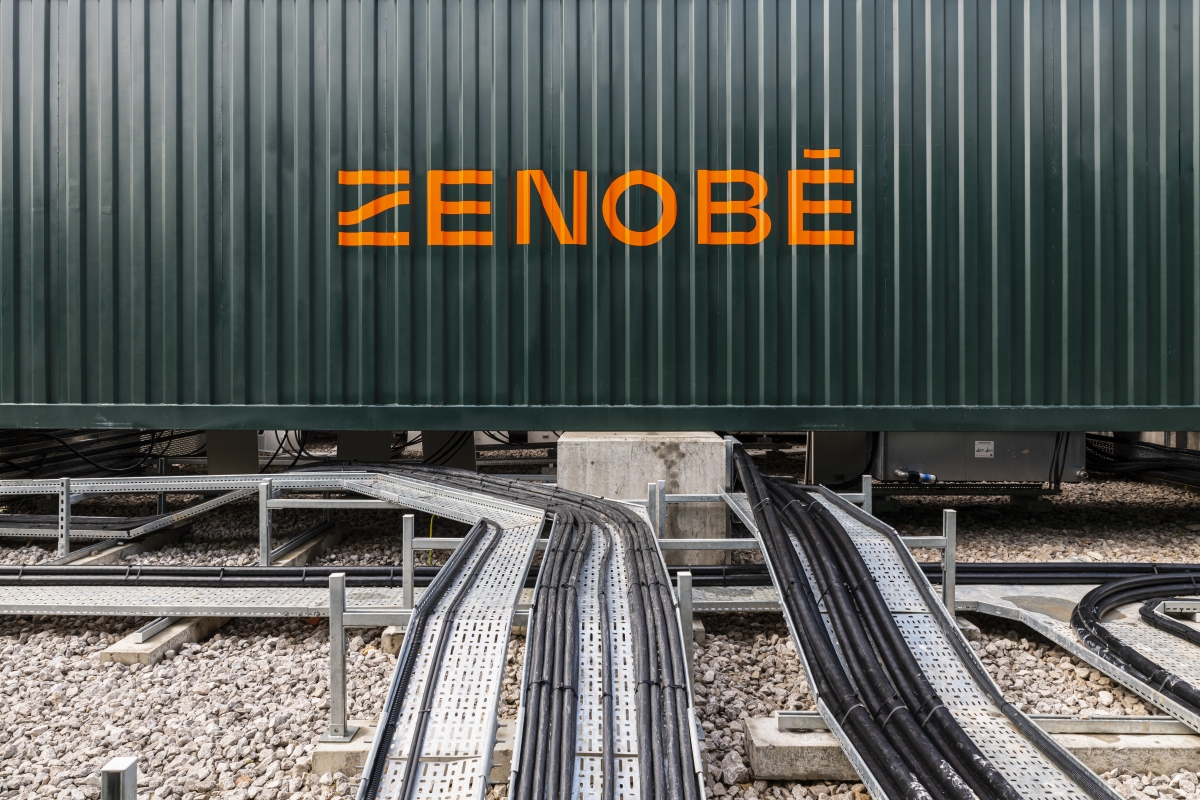Zenobē breaks ground on pioneering 300MW battery project in Blackhillock

16th February 2023
- Zenobē has reached financial close on Phase 1 of the first battery in the world to deliver Stability Services using a transmission-connected battery, allowing a significant acceleration of the UK’s uptake of renewable power
- Zenobē has chosen Wärtsilä, H&MV, SMA Solar Technology AG and GE Grid Solutions as its key suppliers for the project, with funding from a £235m long-term debt facility from five banks
- The battery will provide Scotland with the most advanced technology to manage renewable power globally and forms part of Zenobē’s recently announced £750 million investment in Scotland, that will take the company’s portfolio in the country to over 1GW
- Through enabling more wind power onto the transmission network, the project will avoid c.2.6m tonnes of CO2* from entering the atmosphere over 15 years
- The additional renewable energy resources and increased efficiency will accelerate energy independence and lower consumer bills by over £170 million over 15 years
Zenobē, the international EV fleet and battery storage specialist, today announces it has reached financial close and begun construction on the first 200MW of a pioneering 300MW battery site in Blackhillock, Scotland.
Located between Aberdeen and Inverness, the project, which will be the first in the world to deliver Stability Services using a transmission-connected battery, represents an important milestone in the UK’s net zero transition. It will significantly increase the uptake of renewable power, including from offshore windfarms at Viking and Beatrice, on to the nation’s electricity grid.
When fully built, Blackhillock will be a 300MW / 600MWh project. It will be the first to provide the full suite of active and reactive power services in the world and will be the largest transmission connected battery in Europe when commissioned.
Phase 1 of the project (200MW / 400MW) is due to go live in summer 2024 with Phase 2 (an additional 100MW) due to go live in H2 2026. The site is part of Zenobē’s recently announced £750 million investment in Scotland, taking the company’s storage portfolio in the country to over 1GW.
The storage facility at Blackhillock is contracted to provide Stability Services to National Grid Electricity System Operator (NGESO) to improve the reliability of the UK’s increasingly renewable power system. It will provide short-circuit level and inertia, essential for the grid to function efficiently as fossil fuel plants phase out, and ease network constraints by importing electricity at times of peak renewable generation. The additional renewable energy resources and increased efficiency will accelerate energy independence and lower consumer bills by over £170 million over 15 years.
Zenobē has selected a multitude of market leading suppliers that are developing key technologies to deliver large scale battery storage facilities. SMA Solar Technology AG will provide the Grid Forming Solution, battery inverters and medium voltage power stations with Wärtsilä appointed as the Battery Energy Storage System (BESS) supplier. H&MV will provide Balance of Plant works and GE Grid Solutions will deliver two 180 MVA transformers to the project. RJ McLeod, a Glasgow-based civil engineering and building contractor, has been brought on for site works.
The development of the project is an important step for Scotland and its 2045 net zero journey. It closely follows the publication of the country’s Draft Energy Strategy and Just Transition Plan that recognises the need to increase grid scale battery storage capacity. The draft strategy calls for the delivery of 20GW of additional low-cost renewable electricity generation capacity by 2030, including 12GW of onshore wind.
The funding for the project is the largest Project Finance facility for battery storage ever to be arranged in Europe. It is financed by a £235m long-term debt facility structured by NatWest with funding comes from Canadian Imperial Bank of Commerce, Rabobank, Santander UK, Siemens Financial Services through Siemens Bank and NatWest.
Through enabling more wind power onto the transmission network, over the next 15 years the site is forecast to avoid c.2.6m tonnes of CO2 from entering the atmosphere.
James Basden, Co-founder and director of Zenobē, says:
“Our battery at Blackhillock will use cutting edge technology to provide essential services needed to lower consumer bills and bring more renewable energy onto the grid. By partnering with experts at Wärtsilä, H&MV, SMA Solar Technology AG and GE Grid Solutions, we look forward to bringing this project to fruition and accelerating the UK towards a zero-carbon energy system.
This is one of several major battery flexibility projects we’re working on in Scotland at the moment, shaping the future for how grid scale battery projects will work on grids across the globe.”
Andy Tang, Vice President, Energy Storage & Optimisation at Wärtsilä, says:
“Wärtsilä is proud to deliver this pioneering energy storage project alongside Zenobē. This is a first-of-its-kind project that will help balance the UK grid as it targets 100% renewable energy generation.
Energy storage is playing a critical role in delivering a stable supply of electricity during the global transition to renewable energy. Alongside our partners and customers, Wärtsilä is leading the charge to a clean energy future.”
Jason Devonshire-Mander, Head of Sales & Service at SMA Solar UK, says:
“We are proud in contributing to Zenobē’s unique lighthouse project. This power plant not only solves the time-shift between demand and renewable generation, but also contributes to system stability. The SMA Grid Forming Solution stabilizes frequency and voltage instantly and inherently. These kinds of stability plants are the missing link to 100% renewables and value stacking reveals this cost effective solution compared to traditional technologies. We are looking forward to provide our system know-how and dedication to this project and the ones to come.”
Asad Babadi, Managing Director of H&MV Engineering UK, says:
“The award of this ground-breaking project reflects the confidence that this major client has in H&MV Engineering’s ability to deliver critical and complex projects. Our inhouse global design team are working on this pioneering design solution to connect this BESS at 275 kV to Scottish Power and we are delighted to be starting on site.
The award of this project is further validation of H&MV’s experience in delivering comprehensive solutions for high voltage grid connections up to 400 kV in the UK. We are looking forward to working with Zenobē and Scottish Power to get this project completed safely and on programme.”
END
Notes to editors
Explanation of stability services:
Renewable energy sources interact with the electricity grid differently from coal and gas plants. Fossil fuelled power plants deliver certain key grid services, such as short circuit level, reactive power, and inertia, as a by-product of their normal operations. Short circuit level maintains system voltage during a fault. Inertia, which is derived from the kinetic energy stored in rotating turbines, prevents sudden changes in system frequency. Renewable power sources do not provide these services consistently so to decarbonise successfully, it is necessary to find alternative, reliable sources of grid stability – not only in the UK but worldwide.
Sources and calculations to back up figures:
- * This number was updated on 11/12/24, in-line with our most up-to-date reporting methodology. Learn more here.
- Consumer savings of £170m reflects savings of £9m from the Stability Pathfinder contract and savings of £164m from providing balancing services and constraint management to the grid and helping reduce price volatility. The £9m of consumer savings assumes that the stability contract (9-10yr contract length), secured for Blackhillock project, will avoid the use of CCGT’s, which would otherwise be out-of-merit, to provide inertia and SCL. CCGT efficiency assumed at 55% and Stable Export Limit of 35%. Average gas price over contract length assumed at £40/MWh, which is conservative considering the high price outlook for gas over the next decade. The £164m of balancing services and constraint management assumes that the asset cycles twice a day and provides a reasonable level of savings to the control room vs the alternative actions that would be taken e.g. curtailing wind for bid actions during constraints, more competitively priced offer actions than gas peakers / CCGTS.
For further information, please contact:
zenobe@standagency.com | 07551 579135
About Zenobē Energy Ltd. (Zenobē):
Zenobē is an international EV fleet and grid-scale battery storage specialist, headquartered in the UK with operations in Europe and Australasia. It has c. 1.6GW of battery storage in the UK either in operation, in construction or in late stage development which equates to c.25% market share forecast by 2026. It has around 25% market share of the UK EV bus sector and c.1000 electric vehicles contracted globally. The company is the largest owner and operator of EV buses in the UK, Australia and New Zealand.
The company’s pioneering battery storage offering enables power grid operators to provide clean, secure and affordable power, accelerating the global transition to Net Zero energy systems. Zenobē’s fleet solution is driving the adoption of electric vehicles and reducing emissions from the transport and logistics sectors. Its ETaaS (Electric Transport-as-a-Service) solution provides fleet operators and local authorities with a full solution for a pay-per-month fee including charging infrastructure, battery replacement and award-winning software. Zenobē is also a leader in second life battery repurposing EV batteries after their first life, providing incremental power solutions to large business and the film and events industries.
For more information, please visit www.zenobe.com/
